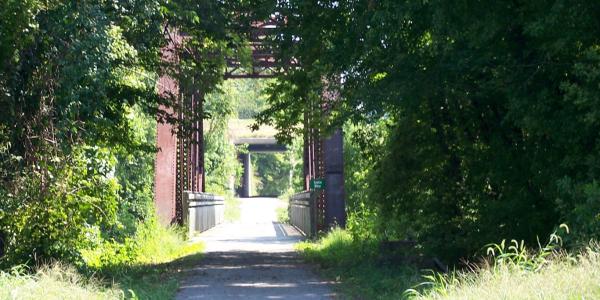Arts & Sciences researchers Bill Lowry and Scott Krummenacher examine the power of coalitions in conserving natural spaces.
In November 2016, Missouri voters went to the polls and did something nearly unprecedented in modern politics: Over 80 percent of them agreed on something. Missourians greenlighted the Parks, Soils, and Water Sales Tax for another decade, giving it the largest thumbs-up since its inception in 1984. The measure allocates one-tenth of one percent of sales taxes to support state parks and soil conservation measures. Roughly 90 percent of state park funds derive from this tax.

“That’s a big chunk of money that our state park system gets that they don’t have to worry about, because they know that they’re going to get it every year,” said Bill Lowry, professor of political science and of environmental studies. “Missouri isn’t considered a leader in basically any type of policy – but we are in state parks.”
How did Missouri, an electoral battleground that’s crept more and more toward red in the last few election cycles, become a national leader in public land conservation? Like anything in politics, the answer is complicated.
Lowry and Scott Krummenacher, a lecturer in environmental studies with expertise in urban land policy, have been compiling data on some 2,600 conservation ballot measures, spanning 30 years, at the local, city, and state levels. Such ballot measures have become more common over the past few decades, as federal allocations from the Land and Water Conservation Fund started declining in the 1980s. “Ballot measures became the state and local response when federal money gets pulled away,” said Krummenacher.
How did Missouri, an electoral battleground that’s crept more and more toward red in the last few election cycles, become a national leader in public land conservation?
Sifting through this database, Lowry and Krummenacher are beginning to understand the factors that help push conservation ballot measures across the finish line. Coalitions of support from diverse interest groups are one major force, they say.
Coalition support can determine whether conservation efforts ultimately succeed with voters, they explain in a recent study, especially when a measure has diverse goals and high stakes. A ballot measure is more likely to gain support from diverse interests when it’s aimed at more than just conservation, Lowry said. Recreation, irrigation, and agricultural interests tend to pair well with conservation efforts, at least in terms of coalition support.
For example, a partnership among environmental groups and transportation groups interested in curbing emissions might be one effective strategy for getting a conservation measure on the ballot, Krummenacher said. Another potent combination is hunters, fishermen, and conservation groups.
He and Lowry next plan to study how coalitions form, as well as the impacts of political polarization on public policy.
“The biggest trend in American politics over the last 30 years is polarization,” said Lowry. Data show that as political polarization increases, the purity of legislation – how dedicated a particular ballot measure is to one specific issue – tends to decrease. “What’s interesting about that argument is it’s not just related to land conservation; I think it’s related to just about everything.”
Krummenacher agreed. “If there’s lack of purity on a wildly successful issue like conservation — around 75 percent of those initiatives end up passing — that’s pretty damning for other issues, where things are even more contested.”
A 2014 conservation measure in Florida is an example of a low-purity effort going awry. A broad coalition of more than 100 groups, ranging from business interests to grassroots environmental organizations, amassed more than a million signatures in support of an $18 billion land conservation amendment. The measure passed with sweeping statewide support, but it was written in such broad language that public officials diverted much of the funding away from land conservation, instead using it for sewer and water infrastructure and recreational programs. Environmental groups are now suing the state for misuse of funds.

Missouri’s success, on the other hand, comes from a long-term, strategic alliance between the state parks system and agricultural interests. Funding from the Parks, Soils, and Water Sales Tax goes toward both parks and soil conservation. That’s key, Lowry said, because it means money flows to parks and to agricultural groups, helping maintain the strong coalition. In addition to funding state parks, the sales tax has paid farmers $694 million for implementing conservation practices that have saved more than 179 million tons of soil from eroding away over the last 34 years, according to the Missouri Department of Natural Resources.
Missouri’s success ... comes from a long-term, strategic alliance between the state parks system and agricultural interests.
But Lowry thinks another, more sentimental narrative may also be at play.
“Public lands are exceptional,” he said. “Even in a state like Missouri, people care about public lands. Hunters and fishermen love them. Voters may not want pollution regulations, but state parks – ‘Hey, let’s keep some of this land wild!’”
The outlook for future land conservation efforts is mixed, Lowry and Krummenacher say. On the national political scene, current efforts to dismantle environmental protections will likely be met with powerful backlash. Hunting and fishing groups, for example, are already pushing back against federal efforts to relax protections – another indicator of the importance of coalitions, Krummenacher noted. “Hunters and fishermen don’t necessarily want to see more federal lands opened up for mining; they want those lands for recreation and conservation.”
Recent efforts to engage people of color with public lands, by groups like Outdoor Afro and the Next 100 Coalition, may provide important new partnerships. Networks of trained African American volunteers lead activities such as hiking, biking, camping, and environmental education in 30 states through Outdoor Afro. The Next 100 Coalition advocates for cultural inclusion in public lands, and the group is building a visible presence in state and national public lands debates. “As the country continues to diversify over time, engaging people of color will be critical to the preservation of these spaces,” said Krummenacher.
Younger generations will also play a key role in determining the fate of public lands. Lowry noted that although young people are often more concerned about the environment, they are much less likely to use public lands than their parents and grandparents were. They’re also much less likely to vote. “That’s a worry,” Lowry said. “We need these people to get out and vote.”





